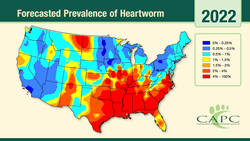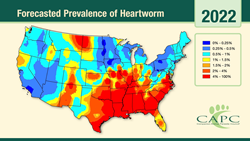
The nonprofit Companion Animal Parasite Council (CAPC) — the nation’s leading source on parasitic diseases that threaten the health of pets and people — released its annual 2022 Pet Parasite Forecast.
CAPC’s 2022 Pet Parasite Forecast is critical to alerting pet owners to the risks this year and reinforcing CAPC’s recommendation that all pets need to be annually tested and protected year-round.
SALEM, Ore. (PRWEB)
February 27, 2022
The nonprofit Companion Animal Parasite Council (CAPC) — the nation’s leading source on parasitic diseases that threaten the health of pets and people — today released its annual 2022 Pet Parasite Forecast. CAPC’s 2022 forecast warns that vector-borne diseases — heartworm, Lyme, ehrlichiosis and anaplasmosis – will all pose higher-than-average risks across much of the country this year. Recognized as the global expert in forecasting vector-borne diseases of U.S. companion animals, CAPC also publishes corresponding 30-day Pet Parasite Forecast Maps to complement the annual forecast and to alert pet owners of impending outbreaks on a monthly basis in every county across the United States.
In its 2022 annual forecast, CAPC reports that heartworm disease, which is transmitted by mosquitoes, and tick-borne diseases Lyme, ehrlichiosis and anaplasmosis, continue to spread throughout the United States. Risks have increased due to rehoming of pets, as well as changes in:
-
Distribution and prevalence of vector (mosquito and tick) populations; - Shifting wildlife populations and their incursion into newly developed and reclaimed areas
- Short- and long-term changes in climatic conditions
- Changes in habitat due to natural or human-induced processes
The 2022 forecasts — supported by ongoing research by parasitologists and statisticians in leading academic institutions across the United States — highlight areas where more should be done to lower the risk of companion animals’ exposure to disease vectors, such as mosquito and ticks. The foundation of these prevention strategies are recommendations that veterinarians and pet owners test their pets annually for disease and protect their pets with products that kill/or repel mosquitos and ticks, as well as year-round heartworm prevention.
“Because of the zoonotic potential of parasites, we started providing our annual forecasts to alert communities to the risk they pose to people and pets locally,” says Dr. Christopher Carpenter, DVM and Chief Executive Officer of CAPC. “Over the years, we’ve seen the risk for parasitic diseases increase and expand into areas that have had historically lower prevalence. CAPC’s 2022 Pet Parasite Forecast is critical to alerting pet owners to the risks this year and reinforcing CAPC’s recommendation that all pets need to be annually tested and protected year-round.”
For 2022, CAPC’s 2022 Pet Parasite Forecast predicts the following risk areas for parasite-related diseases:
Heartworm Forecast 2022:
According to CAPC, the risk of acquiring heartworm disease in 2022 is very real due to the expansive nature of the disease. Mosquitoes are responsible for the transmission of the parasite that causes heartworm disease, which can be deadly to pets. This increase in heartworm prevalence can be attributed to several factors including warmer and humid weather patterns that create ideal breeding conditions for mosquitoes; transportation of companion animals from one area of the country to another; and pet owners who don’t administer parasite preventatives 12 months of the year.
- Infection with heartworm, which causes a potentially fatal disease, is expected to be higher than average along the Mississippi river, throughout the southern portions of the Midwest, and along the Atlantic coast north into Virginia and southern New Jersey. The prevalence of heartworm continues to increase in the mid-Atlantic region, pushing northward into the densely populated regions of the northeast. The number and diversity of mosquitoes teamed with the population densities of the region support that heartworm infections are more likely to affect the health of increasing numbers of dogs in those areas.
- Additional areas likely to experience increased risk include the southwest (New Mexico and southern Arizona), large portions of Colorado and Kansas, and the northern Great Plains.
- As reported last year, forecast of increased risk continues in northern California, Idaho and eastern Montana.
- Much of the upper Midwest and the Northeast will have little change, perhaps indicating that increased emphasis on vector control and compliant heartworm prevention are having an impact in these regions. It’s important to remember that areas of increased risk are likely to remain in some areas within these regions.
- Veterinarians and pet owners in states with historically lower prevalence are cautioned about the increasing risk of heartworm infection. This is particularly important in Indiana, central and northern Illinois, southern Iowa, and lower Michigan and Ohio in the Great Lakes region.
- The intriguing increase in risk reported last year in much of central and southern Florida remains. The pandemic of 2020 may have affected pet disease prevention strategies – such as veterinary visits and testing – in Florida and other regions of emerging risk.
- Very few regions are expected to have lower-than-average prevalence. It is important to remember that changes in local environments could create risks that might not be evident in the broader regional forecasts.
- Annual testing and year-round use of preventive products remains the best means of providing comprehensive internal and external parasite control.
Lyme Forecast 2022:
CAPC also predicts that Lyme disease, a potentially fatal disease for pets, is expanding quickly. Transmitted by ticks, Lyme disease is spreading due to the expansion of tick host habitat range, primarily deer and rodents, and migratory birds carrying ticks to new areas. Warmer weather and longer seasons for tick reproduction is also a factor. Veterinarians and pet owners should test pets annually and use tick preventatives year-round. A vaccination for Lyme disease should always be considered for pets in high-risk areas.
- The geographic prevalence of Lyme disease continues to expand southward and westward.
- CAPC expects increases beyond last year’s forecasts in eastern Kentucky, northeastern Tennessee, western Michigan, and Ohio.
- High-risk “hot-spots” are again predicted in northern and western lower Michigan, and southern and northeastern Ohio.
- High risks of Lyme disease persist in all portions of the Northeast, the upper mid-western states of Wisconsin, Minnesota and the upper peninsula of Michigan. A higher-than-normal risk continues in North Dakota, northeastern South Dakota, Iowa, Illinois, and eastern Kentucky.
- The southward movement of Lyme disease is also evident in the increasing risk in the Carolinas and Tennessee. Higher risk areas in east central South Carolina and most of coastal North Carolina appear for the first time in the 2022 forecast. These emerging threats validate and emphasize CAPC reminders that pets and pet owners do not have to travel to the traditional endemic areas of the Northeast to encounter substantial Lyme disease risks.
Ehrlichiosis Forecast 2022
Ehrlichiosis, transmitted by ticks, is expected to be above normal for the majority of the United States, with some interesting emerging risk areas.
- The forecasted risks of Ehrlichiosis remain high throughout the coastal Atlantic states, as well as in central California, northern Idaho and western Montana. Risks also continue in Colorado and Wyoming.
- Emerging new species of Ehrlichia have complicated the prevalence maps in parts of Wisconsin and Minnesota, and should emphasize the need for testing and prevention in these areas.
- Considering the widespread prevalence of Ehrlichia throughout the U.S., the continued use of acaricides, routine examination of pets for the presence of ticks, with prompt removal, remains imperative. Testing of symptomatic pets can help monitor the prevalence of ehrlichiosis and also reinforce the use of tick-control products.
Anaplasmosis Forecast 2022
Anaplasmosis, also transmitted by ticks, poses major risks for pets in the Northeast and upper Midwest.
- Higher-than-average risk continues in portions of Virginia, West Virginia, and Texas. These areas have historically had a lower risk of exposure, so veterinarians and pet owners should remain vigilant. Like Ehrlichia, the presence of more than one species of Anaplasma in some areas can create confusion, particularly in asymptomatic pets. Aggressive and compliant tick control can help eliminate some of the confusion.
- Veterinarians in these regions should reinforce year-round use of tick preventives and pet owners should regularly check their dogs for ticks. Annual testing can aid in assessing risk for dogs in high-risk areas.
Pet owners and veterinarians who want to monitor parasitic disease risk in their county throughout the year now have access to 30-Day Pet Parasite Forecast Maps at http://www.petdiseasealerts.org. These maps, developed exclusively by CAPC, provide a local forecast for every county in the continental United States and are updated on a monthly basis. This free service informs pet owners about the continuous risk in their local communities reminds them about the importance of annual parasite testing and year-round parasite protection.
In addition, CAPC is the first and only organization to forecast flea activity across the United States. Updated daily, the Flea Forecast Maps display flea activity nationally based on environmental conditions. The Flea Forecasts also offer a unique look at the historical movement of fleas in a rolling 12-month time-lapse video. This compelling video shows changes in flea activity over the previous 12-month period. One of the most common external parasites of dogs and cats, fleas cause discomfort, allergic reactions in pets and are a source of disease in humans. The Flea Forecasts are a strong reminder to pet owners to protect pets year-round with flea control products, limiting infestations on pets and preventing establishment of flea populations in the home.
For more information about the Companion Animal Parasite Council visit http://www.capcvet.org. To view local 30-Day Pet Parasite Forecast Maps and the daily Flea Forecast, visit http://www.petdiseasealerts.org.
How the forecasts are created
The annual CAPC Pet Parasite Forecasts are a collaborative effort from parasitologists and statisticians in leading academic institutions across the United States who engage in ongoing research and data interpretation to better understand and monitor vector-borne disease agent transmission and changing life cycles of parasites. The forecasts are based on many factors including temperature, precipitation, and population density.
About the Companion Animal Parasite Council
The Companion Animal Parasite Council (http://www.capcvet.org) is an independent not-for-profit foundation comprised of parasitologists, veterinarians, medical, public health and other professionals that provides information for the optimal control of internal and external parasites that threaten the health of pets and people. Formed in 2002, CAPC works to help veterinary professionals and pet owners develop the best practices in parasite management that protect pets from parasitic infections and reduce the risk of zoonotic parasite transmission.
Share article on social media or email:

